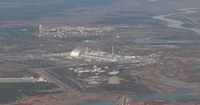The Zaporizhzhia nuclear power plant, Europe’s largest and a symbol of Ukraine’s energy infrastructure, stands at the center of mounting international concern as it enters its longest power outage since the onset of the war. On October 1, 2025, the facility—currently under Russian control—faces the chilling prospect of a Chernobyl-style meltdown if offsite power is not restored within days, according to the International Atomic Energy Agency (IAEA). The plant’s six reactors, though shut down for more than three years, remain vulnerable, their safety now reliant on emergency diesel generators that keep essential cooling and security functions running. As the world watches, the situation teeters on a knife’s edge, drawing historical parallels and raising urgent questions about the risks of nuclear conflict in a war zone.
The backdrop to this crisis is a region haunted by the specter of the 1986 Chernobyl disaster, when a catastrophic reactor failure in Pripyat, Ukraine, unleashed radioactive contamination across Europe and the Soviet Union. That meltdown, triggered by a loss of power and subsequent chain reaction, resulted in the deaths of 30 workers and firemen from acute radiation syndrome and thermal burns, and forced the evacuation of more than 100,000 people. The long-term fallout included widespread contamination, economic devastation, and a marked increase in thyroid cancer among children exposed to radioactive iodine. Today, the echoes of that tragedy inform every decision and every warning issued by nuclear experts and political leaders alike.
At Zaporizhzhia, the immediate threat stems from the loss of external power—a lifeline for any nuclear facility. The plant’s emergency diesel generators, described as the “last line of defense” by IAEA Director General Rafael Mariano Grossi, have so far maintained critical cooling for the shutdown reactors and spent fuel. “While the plant is currently coping thanks to its emergency diesel generators—the last line of defense—and there is no immediate danger as long as they keep working, it is clearly not a sustainable situation in terms of nuclear safety,” Grossi emphasized in a recent statement, as reported by The New York Sun. He warned, “Neither side would benefit from a nuclear accident.”
The IAEA is now working feverishly with military officials from both Russia and Ukraine to facilitate the restoration of offsite power. Yet, the tense military standoff in the area has stymied repair efforts, with both sides accusing each other of endangering nuclear safety. The European Union has weighed in, underscoring the need for Ukrainian authorities to regain control of the plant. “Returning the ZNPP to the full control of the competent and legitimate Ukrainian authorities is the only lasting solution to minimise the risk of a nuclear accident with global implications,” EU officials stated, according to The New York Sun.
The crisis at Zaporizhzhia is not unfolding in isolation. On the same day, Ukrainian President Volodymyr Zelenskiy accused Russia of deliberately attacking and cutting power to the decommissioned Chornobyl nuclear power plant—a site infamous for the world’s worst nuclear accident. According to Reuters, Zelenskiy alleged that more than 20 Russian drones, identified as Russian-Iranian Shaheds, targeted the town of Slavutych, resulting in a three-hour outage at Chornobyl. The attack also severed electricity to 307,000 customers in the Chernihiv region and left the new safe confinement structure over the destroyed fourth reactor without power, raising concerns about the integrity of the containment system designed to prevent radioactive release.
“The Russians could not have been unaware that a strike on facilities in Slavutych would have such consequences for Chornobyl,” Zelenskiy wrote on Telegram, as quoted by Reuters. He characterized the drone assault as a “deliberate attack,” highlighting the continued presence of large quantities of spent fuel at the site.
Ukraine’s energy ministry confirmed that the power loss affected the new safe confinement facility, which isolates the destroyed reactor and prevents radioactive materials from escaping into the environment. While the IAEA acknowledged “fluctuations” after Chornobyl lost its external power connection, it noted that alternative lines were used initially and power was later restored. The ministry did not state that the outage increased the risk of radioactive release, but the event has nonetheless heightened anxieties about the vulnerability of nuclear sites in a conflict zone.
At Zaporizhzhia, the situation remains dire. Zelenskiy has repeatedly accused Russia of “doing absolutely nothing to fix the situation or allow Ukrainian specialists to restore the external power supply to the plant.” He contends that Moscow is “deliberately creating the risk of radiation incidents, exploiting, unfortunately, the weak position of the IAEA and its Director General, Rafael Grossi, as well as the dispersion of world attention.” The plant has now been without external power for eight days, an unprecedented duration that has alarmed international observers.
The Kremlin, for its part, insists that it is doing everything possible to ensure the safety of Zaporizhzhia. Spokesman Dmitry Peskov told reporters, as cited by Reuters, that the plant “had come under repeated fire from Ukrainian forces.” Since Russia seized Zaporizhzhia in the early weeks of its 2022 invasion, accusations have flown back and forth, with each side blaming the other for jeopardizing nuclear safety.
The IAEA’s Grossi has sought to calm fears, stating that “there is no immediate danger from the power cutoff as emergency diesel generators were in operation.” However, he has also been unequivocal about the need to restore external power lines, warning, “Nevertheless, it is extremely important that offsite power is restored. I strongly encourage both sides to work with us and enable these essential repairs to take place.”
For now, the reactors at Zaporizhzhia remain in a stable condition, with the nuclear fuel inside having cooled over three years of shutdown. Still, the risk of meltdown lingers if emergency systems fail or if fresh attacks further compromise the plant’s infrastructure. The memory of Chernobyl looms large, a grim reminder that even dormant reactors can pose catastrophic dangers if left without the safeguards that only stable power supplies can provide.
As diplomatic efforts continue and technical teams scramble to restore power, the fate of Zaporizhzhia hangs in the balance. The world has been here before, and the consequences of inaction—or miscalculation—are all too familiar. The next few days will be critical in determining whether Europe’s largest nuclear plant can avoid becoming the site of another historic disaster.




